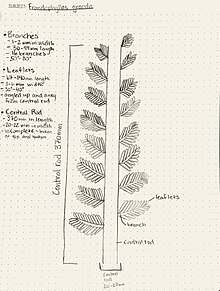| Frondophyllas | |
|---|---|

| |
| A sketch of Frondophyllas published in the Journal of Paleontology by a student at Michigan State University. | |
| Scientific classification | |
| Domain: | Eukaryota |
| Kingdom: | Animalia |
| Phylum: | †Petalonamae |
| Clade: | †Rangeomorpha |
| Genus: | †Frondophyllas |
| Species: | †F. grandis
|
| Binomial name | |
| †Frondophyllas grandis Bamforth & Narbonne, 2009
| |
Frondophyllas[1] is an extinct, monotypic animal genus in the clade Rangeomorpha. It was found at the Mistaken Point on the Avalon Peninsula in Newfoundland, Canada in 2008 by Bamforth and Anderson.[2] The single species is Frondophyllas grandis and as of 2021[update] only two specimens have been discovered. Both specimens are incomplete, but one extends to one meter long, making it one of the largest Ediacaran macrofossils. The species name: grandis, comes from its size, and the genus name: Frondophyllas means "frond with leaves". The organism has a base structure with numerous fronds attached to it. It is the only Ediacaran organism to have distinct leaflets. Evidence suggests that F. grandis may have been tethered to the seafloor and used these leaflets to "filter feed", or live off nutrients provided by a current. One of the reasons fossils of this species are so rare is because it was a soft-bodied organism. It is believed that F. grandis was preserved because it was caught beneath quickly solidifying volcanic ash. Many of the Mistaken Point fossils were preserved this way.[3]
- ^ Clapham, Matthew E.; Narbonne, Guy M.; Gehling, James G. (2003). "Paleoecology of the oldest known animal communities: Ediacaran assemblages at Mistaken Point, Newfoundland". Paleobiology. 29 (4): 527–544. doi:10.1666/0094-8373(2003)029<0527:POTOKA>2.0.CO;2. ISSN 0094-8373. S2CID 45514650.
- ^ Bamforth, Emily (July 2008). "MULTIBRANCHED RANGEOMORPHS FROM THE EDIACARAN MISTAKEN POINT ASSEMBLAGE, NEWFOUNDLAND, CANADA" (PDF).
- ^ Bamforth, Emily L.; Narbonne, Guy M. (2009). "New ediacaran rangeomorphs from Mistaken Point, Newfoundland, Canada". Journal of Paleontology. 83 (6): 897–913. doi:10.1666/09-047.1. ISSN 0022-3360. S2CID 86227242.